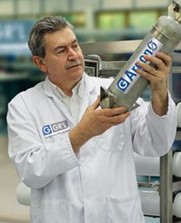Disposal of solvents and gases are costly and wasteful but these are externalities for the producer.
An externality is a positive or negative outcome of a given economic activity, such as pollution or traffic congestion, that affects a third party that is not directly related to that activity. Without the externalities being factored into the prices of products and services, nature-positive business models that reduce or eliminate environmental externalities may initially be less attractive than business-as-usual models. So how can innovators tip the balance in their favour?
Early stage company H2Upgrade’s strategy is to create value. It has developed a technology that extracts food grade CO2 and creates high purity hydrogen from industrial waste streams (gases and solvents).
Case-study: H2Upgrade
H2Upgrade is a spin-out from the University of Cambridge. We talked to Ewa Marek and Rob Grant of H2Upgrade about the challenges of introducing a disruptive technology that internalises the problem of pollution which is normally ‘externalised’ (see Steve Evans interview.)
Embracing externalities with a circular economy
A mind set change is one of the factors needed to facilitate the adoption of this waste to hydrogen solution explains Rob Grant of H2Upgrade, as currently the industry pays for waste to be incinerated.
“This is a disruptive technology, as there are no waste to hydrogen systems currently available and so companies pay to have their waste solvents removed, and incinerated, and also pay for hydrogen to use in their processes. They would need to embrace the concept of local processing of this waste material into a value-added product, and this would require adoption of a new business model.

New business model required by client
For generation of hydrogen onsite, the closest competitor comes from electrolysis of water or purchasing of hydrogen in gas cylinders, Rob explains.
“The business model is to develop a product and to either sell it directly to the industrial unit or to provide an onsite service replacing the current incineration service offered by waste management companies.
“The waste management companies are also a potential customer for this technology but maybe operating on a larger scale than we would be able to support at present.
“We have spoken to a number of potential end users of our technology and they have commented that there is a clear business proposition.
“The technology is at TRL4 and we need to build a full size unit to fully demonstrate the technology.”

